The Dogger Group above the Opalinus Clay is characterised by contrasting lithologies (Section 4.2.7). There is an important vertical variation along individual boreholes and there are also lateral facies changes between the different boreholes. In this section, the mostly clay-mineral-rich units of the Dogger Group above the Opalinus Clay are discussed. The Hauptrogenstein aquifer and the «Herrenwis Unit» are presented in separate sections.
For the NL and ZNO siting regions, this unit refers to the clay-mineral-rich «Brauner Dogger» studied in detail during SGT Stage 2 (Nagra 2014f). With the new TBO boreholes, the hydrogeological dataset was substantially complemented, notably by hydraulic packer testing (see also Section 5.6) and by investigations of natural tracers in the porewater (Section 4.6). The hydraulic conductivities from the boreholes within the siting regions are very low (< 10-11 m/s; Fig. 4‑85)11 and the profiles of the natural tracers in the porewater show no anomalies. That is, these units are part of the zone with diffusion-controlled transport and thus additionally contribute to the geological barrier. This is particularly robust in the eastern part of the NL siting region where the section below the «Herrenwis Unit» is characterised by high clay-mineral contents ensuring substantial self-sealing behaviour (Fig. 4‑33). In ZNO, the clay-mineral contents in the section above the Opalinus Clay are significantly lower but, at the resolution of the geophysical logs (ca. 0.4 m), are in a range where some self-sealing limits the transmissivities of fractures (Sections 5.2.3 and 5.6.3.2). Here, the Wedelsandstein Formation is characterised by a layered sequence of clay-mineral-rich sediments and thin so-called "hard beds" consisting of silty to sandy limestones (Section 4.2.7). The hydraulic significance of the latter was controversially discussed in SGT Stage 2 (Nagra 2014f) and was of particular interest in the TBO investigations. The new investigations do not provide evidence for hydraulically active fracture networks or a permeable matrix. The low hydraulic conductivities indicated from the in-situ tests and from matrix tests (Section 5.6) can be explained by cementation of these "hard beds" giving rise to particularly low porosity (example shown in Fig. 4‑89). Above the Wedelsandstein Formation in ZNO, the clay-mineral-rich section (Fig. 4‑85) comprising the «Parkinsoni-Württembergica-Schichten» and the Variansmergel Formation constitutes a caprock of significant thickness (Section 4.2.7).

Fig. 4‑89:Profile of the Wedelsandstein Formation in the TRU1 borehole: mineralogical composition, porosity, structural inventory and hydraulic conductivity
The black dashed line (20 wt.-% clay content) is used to highlight the clay-poor intervals. Sections poor in clay minerals ("hard beds") are characterised by low porosity. The hydraulic conductivities are very low despite the partly low clay-mineral contents and the increased structure frequency.
In JO, the Passwang Formation is located between the Opalinus Clay host rock and the Hauptrogenstein aquifer. It has some similarities to the Wedelsandstein Formation in ZNO in terms of a succession of clay-mineral-rich sediments with interlayered "hard beds" (Section 4.2.7). The low hydraulic conductivities (Fig. 4‑85) and the absence of significant excursions in the profiles of the natural tracers (Section 4.6) confirm the aquitard character and that this unit is part of the low-permeability geological barrier. As in the case of the Wedelsandstein Formation in ZNO, the lower clay-mineral contents compared to the equivalent unit in NL below the «Herrenwis Unit» indicate a lower self-sealing potential.
In the BAC1 borehole the section directly above the Opalinus Clay was affected by a drilling-induced fracture. In the SLA1 borehole east of ZNO, a test indicated 1 × 10-9 m/s. The cause for this increased K value is unclear. ↩

